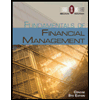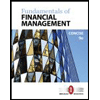This is a more difficult but informative problem. James Brodrick & Sons, Incorporated, is growing rapidly and, if at all possible, would like to finance its growth without selling new equity. Selected information from the company's five-year financial forecast follows. Year Earnings after tax ($ millions) Capital investment ($ millions) Target book value debt-to-equity ratio (%) Dividend payout ratio (%) Marketable securities ($ millions) (Year 8 marketable securities = $200 million) 1 2 3 4 5 100 148 188 257 300 180 300 300 390 580 160 160 160 160 160 ? ? ? ? P 200 200 200 200 200 a. According to this forecast, what dividends will the company be able to distribute annually without raising new equity and while maintaining a balance of $200 million in marketable securities? What will the annual dividend payout ratio be? (Hint: Remember sources of cash must equal uses at all times.) Note: Round dividends to the nearest million dollars and the payout ratio % to the nearest ones place. Year Dividends (millions) Divident Payout ratio (%) ($ millions) 1 2 3 4 5
This is a more difficult but informative problem. James Brodrick & Sons, Incorporated, is growing rapidly and, if at all possible, would like to finance its growth without selling new equity. Selected information from the company's five-year financial forecast follows. Year Earnings after tax ($ millions) Capital investment ($ millions) Target book value debt-to-equity ratio (%) Dividend payout ratio (%) Marketable securities ($ millions) (Year 8 marketable securities = $200 million) 1 2 3 4 5 100 148 188 257 300 180 300 300 390 580 160 160 160 160 160 ? ? ? ? P 200 200 200 200 200 a. According to this forecast, what dividends will the company be able to distribute annually without raising new equity and while maintaining a balance of $200 million in marketable securities? What will the annual dividend payout ratio be? (Hint: Remember sources of cash must equal uses at all times.) Note: Round dividends to the nearest million dollars and the payout ratio % to the nearest ones place. Year Dividends (millions) Divident Payout ratio (%) ($ millions) 1 2 3 4 5
Fundamentals of Financial Management, Concise Edition (with Thomson ONE - Business School Edition, 1 term (6 months) Printed Access Card) (MindTap Course List)
8th Edition
ISBN:9781285065137
Author:Eugene F. Brigham, Joel F. Houston
Publisher:Eugene F. Brigham, Joel F. Houston
Chapter10: The Cost Of Capital
Section: Chapter Questions
Problem 1DQ: As a first step, we need to estimate what percentage of MMMs capital comes from debt, preferred...
Related questions
Question

Transcribed Image Text:This is a more difficult but informative problem. James Brodrick & Sons, Incorporated, is growing rapidly and, if at all possible, would
like to finance its growth without selling new equity. Selected information from the company's five-year financial forecast follows.
Year
Earnings after tax ($ millions)
Capital investment ($ millions)
Target book value debt-to-equity ratio (%)
Dividend payout ratio (%)
Marketable securities ($ millions)
(Year 8 marketable securities = $200 million)
1
2
3
4
5
100
148
188
257
300
180
300
300
390
580
160
160
160
160
160
?
?
?
?
P
200
200
200
200
200
a. According to this forecast, what dividends will the company be able to distribute annually without raising new equity and while
maintaining a balance of $200 million in marketable securities? What will the annual dividend payout ratio be? (Hint: Remember
sources of cash must equal uses at all times.)
Note: Round dividends to the nearest million dollars and the payout ratio % to the nearest ones place.
Year
Dividends (millions)
Divident Payout ratio (%)
($ millions)
1
2
3
4
5
Expert Solution
This question has been solved!
Explore an expertly crafted, step-by-step solution for a thorough understanding of key concepts.
Step by step
Solved in 2 steps

Recommended textbooks for you

Fundamentals of Financial Management, Concise Edi…
Finance
ISBN:
9781285065137
Author:
Eugene F. Brigham, Joel F. Houston
Publisher:
Cengage Learning

Fundamentals of Financial Management, Concise Edi…
Finance
ISBN:
9781305635937
Author:
Eugene F. Brigham, Joel F. Houston
Publisher:
Cengage Learning

EBK CONTEMPORARY FINANCIAL MANAGEMENT
Finance
ISBN:
9781337514835
Author:
MOYER
Publisher:
CENGAGE LEARNING - CONSIGNMENT

Fundamentals of Financial Management, Concise Edi…
Finance
ISBN:
9781285065137
Author:
Eugene F. Brigham, Joel F. Houston
Publisher:
Cengage Learning

Fundamentals of Financial Management, Concise Edi…
Finance
ISBN:
9781305635937
Author:
Eugene F. Brigham, Joel F. Houston
Publisher:
Cengage Learning

EBK CONTEMPORARY FINANCIAL MANAGEMENT
Finance
ISBN:
9781337514835
Author:
MOYER
Publisher:
CENGAGE LEARNING - CONSIGNMENT

Fundamentals Of Financial Management, Concise Edi…
Finance
ISBN:
9781337902571
Author:
Eugene F. Brigham, Joel F. Houston
Publisher:
Cengage Learning